More from the musicians
 By Susan Whitall – From her Blog at DetNews.com
By Susan Whitall – From her Blog at DetNews.com
I’ve gotten more than a few calls from angry musicians this week, in the wake of publicity about the radio protests going on against Rep. John Conyers’ proposed fee for performers that AM and FM radio would have to pay.
Conyers’ Performance Rights Act passed through the Judiciary Committee and now faces a vote by Congress. The Senate has a similar bill it’s considering. Continue reading “More from the musicians” →
Where did our love go?
By Scott Westerman
If you read Mike Austerman and Art Vuolo in January of 2009, you know that their love affair with satellite radio is diminishing as the unified brands struggle to find profitability by cutting personality and tightening the 60s play list. It seems that the decade channels at Sirius/XM are falling victim to the same disease that’s infecting most major radio stations these days. It’s symptoms are homogenization and automation, followed by staff termination. Continue reading “Where did our love go?” →
Cat Stevens performs in U.S. for first time in 33 years
 By Susan Whitall – From her Blog at DetNews.com
By Susan Whitall – From her Blog at DetNews.com
Singer/songwriter Cat Stevens, known now as Yusuf Islam, performed in Los Angeles Monday night in his first U.S. show in 33 years. The concert was invitation-only and packed with famous musicians (Van Morrison was reportedly on the list) and celebrities.
Here’s the Billboard report.
Every Issue of Billboard at Google Books
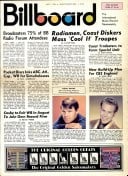 The “Reel” Tom Ryan reports that you can now peruse every issue of Billboard Magazine, from 1942 to 2008, on line over at Google Books.. for free.
The “Reel” Tom Ryan reports that you can now peruse every issue of Billboard Magazine, from 1942 to 2008, on line over at Google Books.. for free.
But that’s just the tip of the iceberg. Do a WKNR word search at Google Books and you’ll find 628 references across hard covers, paperbacks and magazine articles.
Some of the Billboard references include an interview with Keener program director Frank Maruca, who discussed the station’s policy on playing Christmas music and an article announcing the debut of progressive rock on WKNR-FM.
Google Books is a growing library of facsimile reproductions of documents, books and magazines. Its a lot like digging through the microfilm at the library and is a treasure trove for Keenerfans seeking references to our favorite radio station on the web.
Remembering the Grande
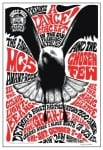 Chris Morton, writing in his Floydian Slips blog, takes us back to the summer of 1967. Tim Buckley was slated to appear at Russ Gibb’s famed Grande Ballroom and as the artist and his host headed toward the venue their path was blocked by the Michigan National Guard. They were told that portions of the city were in flames. Chris goes on to relate how the Grande escaped destruction even as buildings all around it were consumed. Even as the rage was boiling over, people remembered that this was a place where the music lived.. a place worth saving.
Chris Morton, writing in his Floydian Slips blog, takes us back to the summer of 1967. Tim Buckley was slated to appear at Russ Gibb’s famed Grande Ballroom and as the artist and his host headed toward the venue their path was blocked by the Michigan National Guard. They were told that portions of the city were in flames. Chris goes on to relate how the Grande escaped destruction even as buildings all around it were consumed. Even as the rage was boiling over, people remembered that this was a place where the music lived.. a place worth saving.
That’s just one of a thousand footnotes from the storied history of Detroit’s hippest 60s concert spot. Continue reading “Remembering the Grande” →
Mike Nesmith’s video parody
After his departure from the Monkees, Mike Nesmith charted on the WKNR Music Guide with “Joanne“, a tune that helped cement his reputation as a pioneer in the country rock genre. The song had echoes of “Different Drum“, which became a one hit wonder for the Stone Poneys, and a catalyst for Linda Rondstadt’s solo career. Nesmith had an early fascination for incorporating video and music and was a seminal influence on what would become the early format of MTV. Continue reading “Mike Nesmith’s video parody” →
Sonic Boomers
 By Susan Whitall – From her Blog at DetNews.com
By Susan Whitall – From her Blog at DetNews.com
As much as I read online, there’s always something I discover I can’t quite live without. This week it’s Bill Bentley’s Sonic Boomers website.
I found out about Sonic Boomers from a fellow Creem editor who had an old story picked up and republished in the “Past Print” section (this week Jaan Uhelszki’s story on the Allman Brothers is featured); then an interview I did with Frankie Miller for Creem was bought and posted there so I had to check it out.
There’s a great story by Harvey Kubernik on Motown 50 and the Funk Brothers, various music and music book reviews and an eye-opening account by “Miss Vicki” of her brief marriage to Tiny Tim. Who knew that years after their odd marriage was done they still would have screaming arguments over the phone, although three days before he died, they made peace.
Younger generations haven’t a clue what “Tiny Tim” or “Miss Vicki” is all about, but that’s why Bentley calls it “Sonic Boomers.”
Susan Whitall writes about music, books, pop culture, radio and more for The Detroit News. You can reach her at swhitall@detnews.com.
In Praise of Bob Seger
By Scott Westerman – Curator
 May 6th, 1945. The Second World War in Europe ends as the Germans announce that they will sign surrender documents. While most eyes are focused overseas, life goes on in Detroit. At Henry Ford Hospital, Robert Seger is born. By the time he was six the family had relocated to Ann Arbor, Michigan. Seger’s father left the family when Bob was ten and the young man made his way through the Ann Arbor Public Schools, attending Tappan Junior High and graduating from what was then called Ann Arbor High School in 1963.
May 6th, 1945. The Second World War in Europe ends as the Germans announce that they will sign surrender documents. While most eyes are focused overseas, life goes on in Detroit. At Henry Ford Hospital, Robert Seger is born. By the time he was six the family had relocated to Ann Arbor, Michigan. Seger’s father left the family when Bob was ten and the young man made his way through the Ann Arbor Public Schools, attending Tappan Junior High and graduating from what was then called Ann Arbor High School in 1963.
His classmates remember him as an athlete, one of the best runners in the State, and as a man on a mission… to make music. Continue reading “In Praise of Bob Seger” →
Aretha & the Rationals
By Scott Westerman
From the Keener emailbag – Q: I read something in the Free Press about Aretha’s Respect being number one on the Billboard charts the week of June 2, 1967. How popular was it in Detroit and didn’t some other band also have a hit with Respect?
 A: Detroit was always ahead of Billboard in recognizing R&B talent and Aretha Franklin is a classic example. By 1967, CKLW was ascending in popularity in Motown.
A: Detroit was always ahead of Billboard in recognizing R&B talent and Aretha Franklin is a classic example. By 1967, CKLW was ascending in popularity in Motown.
Comparing music guides in June of ’67 you sense that the Bit 8’s music mix was a tad more soulful than what was playing on Keener. Aretha hit number one on CK the week of May 9th, 1967, nearly a month before she peaked on the national charts, and held the top spot for 3 weeks. The song entered the WKNR Music Guide that same week. It had a 5 week run, with one of the biggest jumps in Keener history, a move from number 26 to number 5, during the week of May 15th.
Otis Redding had the first national success with Respect, climbing as high as number 35 on Billboard in 1965. But 9 months before Aretha’s version exploded on the scene, an Ann Arbor band, spent 6 weeks on the Keener charts with the same tune, topping out at number 6 the week of September 26th, 1966.
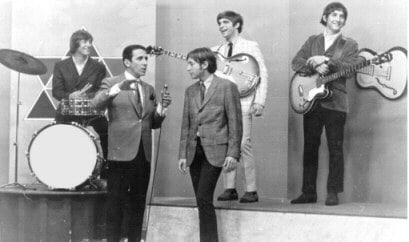 The Rationals, shown here during an appearance on Robin Seymour’s Swingin Time TV show, recorded for Cameo Parkway records. The label that launched Bob Seger’s career was also home to Dee Dee Sharp, Eddie Holman and Chubby Checker. It was a perfect vehicle for Scott Morgan’s bluesy wail, and in the day, the Rationals sound was favorably compared to early Beatles and Rolling Stones recordings. The band charted again in 1968 with I Need You but never enjoyed Aretha’s success. She was featured 22 times on WKNR, hitting number one with Don’t Play That Song and Spanish Harlem.
The Rationals, shown here during an appearance on Robin Seymour’s Swingin Time TV show, recorded for Cameo Parkway records. The label that launched Bob Seger’s career was also home to Dee Dee Sharp, Eddie Holman and Chubby Checker. It was a perfect vehicle for Scott Morgan’s bluesy wail, and in the day, the Rationals sound was favorably compared to early Beatles and Rolling Stones recordings. The band charted again in 1968 with I Need You but never enjoyed Aretha’s success. She was featured 22 times on WKNR, hitting number one with Don’t Play That Song and Spanish Harlem.
Pete Seeger at 90
 On May 3rd, Bruce Springsteen, Dave Matthews, Eddie Vedder, John Mellencamp, Arlo Guthrie, Joan Baez and Emmylou Harris joined dozens of others on the stage at Madison Square Garden to celebrate Pete Seeger’s 90th birthday. Although he never charted on the WKNR Music Guide, his influence on the minds and hearts of those who listened to Keener in the 60s is indisputable.
On May 3rd, Bruce Springsteen, Dave Matthews, Eddie Vedder, John Mellencamp, Arlo Guthrie, Joan Baez and Emmylou Harris joined dozens of others on the stage at Madison Square Garden to celebrate Pete Seeger’s 90th birthday. Although he never charted on the WKNR Music Guide, his influence on the minds and hearts of those who listened to Keener in the 60s is indisputable.
Sunny 105.9’s Bob Berry sent us this link to an article that scratches the surface of the man who’s distinctive voice continues to inspire.
Remebering Paul Harvey
By Scott Westerman
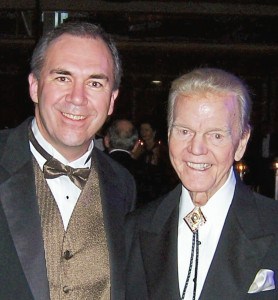 In the days before automation, a rite of passage for many a young disk jockey was running the local control board for Paul Harvey News and Comment. My own experience came in 1971 at Ann Arbor’s WPAG. As the agricultural station for southeastern Michigan and northern Ohio, our noon-time Farm and Home Hour was punctuated with Paul Harvey’s “conversation across the back fence.”
In the days before automation, a rite of passage for many a young disk jockey was running the local control board for Paul Harvey News and Comment. My own experience came in 1971 at Ann Arbor’s WPAG. As the agricultural station for southeastern Michigan and northern Ohio, our noon-time Farm and Home Hour was punctuated with Paul Harvey’s “conversation across the back fence.”
Like the best radio communicators, he understood that he was talking to one person. His writing juxtaposed the small town story with international events, reminding us that what happened in our back yard was just as important as what was happening half way around the world. He knew his listeners well put the events of the day into a perspective that they could understand. His delivery took us through the emotional highs and lows of the news, at times approaching the poetic. Continue reading “Remebering Paul Harvey” →
Motown at 50
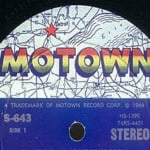 On January 12, 1959, Berry Gordy, Jr. decided to try his hand at making records. He borrowed 800 dollars from his family and started a business that would change the face of American music. Motown’s emergence was perfectly timed. Radio was evolving into a music-centered medium. Elvis Presley had opened the door to bring R&B into the mainstream. And in the industrial Midwest, where tens of thousands of African Americans had migrated to take advantage of auto industry jobs, there was a glut of talented young people with talent, dreams and tenacity.
On January 12, 1959, Berry Gordy, Jr. decided to try his hand at making records. He borrowed 800 dollars from his family and started a business that would change the face of American music. Motown’s emergence was perfectly timed. Radio was evolving into a music-centered medium. Elvis Presley had opened the door to bring R&B into the mainstream. And in the industrial Midwest, where tens of thousands of African Americans had migrated to take advantage of auto industry jobs, there was a glut of talented young people with talent, dreams and tenacity.
When WKMH made the switch to WKNR on Halloween night in 1963, the first WKNR Music Guide featured Marvin Gaye’s “Can I Get a Witness” at number 3. Even thought the station’s playlist still contained more conservative middle of the road artists like Lloyd Price, Vickie Carroll and Lenny Welsh, the fact that the Kingsmen held the number 1 spot made a statement to the audience that things were changing. A year later, four of the top 31 songs of the year were from the Motown family of artists (The Four Tops were at number 1 with “I Can’t Help Myself”). And by the time WKNR left the air in April of 1972, 258 Motown records had charted and nearly one out of every ten WKNR Music Guide artists were connected with the label. Continue reading “Motown at 50” →

